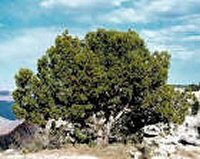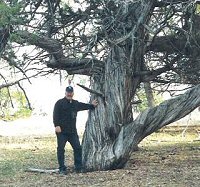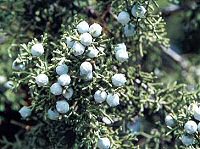Utah Juniper
Cypress Family
Juniperus osteosperma

Of six species of juniper in Arizona, only the Utah juniper grows commonly at the South Rim. The tree is often broad and bunchy, much branched but usually with a single trunk. It grows to over 30 feet tall here, although 15 feet is more common elsewhere. Mistletoe frequents the tree but doesn't kill it unless the tree is weakened. The mistletoe occurs in clumps that turn yellow or orange. This makes the juniper easy to differentiate from surrounding pinyon pines. All native peoples of the area have relied on juniper berries for food at need. The sturdy wood was used in construction.

The bark is gray brown and notably shreddy in long strips. Utah juniper bark was used for cradle board linings by the Ancestral Puebloan Indians. The trunk and limbs tend to twist. Shown is an unusually large specimen.

Juniper fronds are much branched and spiny. The actual leaf is a pointed scale about 1/16 inch long. Utah juniper
"berries" are small, closed cones about 3/8 inch in diameter, with a blue-gray blush over a green color. When green the berries are
bitter and taste of gin, but they smell like Christmas! The berries mature in the fall; each usually contains one bicolored seed that
Navajos string into necklaces and bracelets. By late winter the berries turn purple-brown. These are somewhat sweet.
Male elk browse the juniper by raking their huge antlers through the foliage and then picking the plundered berries and branches
from the ground.